Prepare data for analysis
18 August 2023
Source:vignettes/Prepare-data-for-analysis.Rmd
Prepare-data-for-analysis.RmdIntroduction
In order to estimate behavioral states from telemetry (and biologging
data) using this non-parametric Bayesian framework, the data must be
formatted in a certain way to run properly. This especially applies to
the initial analysis of the raw data by the segmentation model. This
tutorial will walk through the different steps of preparing the raw
telemetry data for analysis by the models within
bayesmove.
But first…
Before we begin in earnest, the practitioner must make sure the data
have been cleaned. This includes the removal of duplicate observations
and sorting the observations in consecutive order per animal ID. At a
minimum, an object of class data.frame with columns for
animal ID, date, x coordinate (e.g., longitude, Easting), and y
coordinate (e.g., latitude, Northing) must be included.
Calculating step lengths, turning angles, and time intervals
In many cases, step lengths and turning angles are used to estimate latent behavioral states from animal movement. Since these metrics are only directly comparable if measured on the same time interval, it is also important to calculate the time interval between successive observations since only those at the primary time interval of interest will be retained for further analysis.
First, let’s take a look at what the data should look like before calculating these data streams:
library(bayesmove)
library(dplyr)
library(ggplot2)
library(purrr)
library(tidyr)
library(lubridate)
# Load data
data(tracks)
# Check data structure
head(tracks)
#> id date x y
#> 1 id1 2020-07-02 11:59:41 0.00000 0.0000000
#> 2 id1 2020-07-02 12:58:26 10.56492 -1.6654990
#> 3 id1 2020-07-02 13:59:31 25.50174 -0.6096675
#> 4 id1 2020-07-02 15:01:27 31.22014 9.5438464
#> 5 id1 2020-07-02 15:59:56 36.15821 19.8737009
#> 6 id1 2020-07-02 16:58:38 39.06810 26.4996352
str(tracks)
#> 'data.frame': 15003 obs. of 4 variables:
#> $ id : chr "id1" "id1" "id1" "id1" ...
#> $ date: POSIXct, format: "2020-07-02 11:59:41" "2020-07-02 12:58:26" ...
#> $ x : num 0 10.6 25.5 31.2 36.2 ...
#> $ y : num 0 -1.67 -0.61 9.54 19.87 ...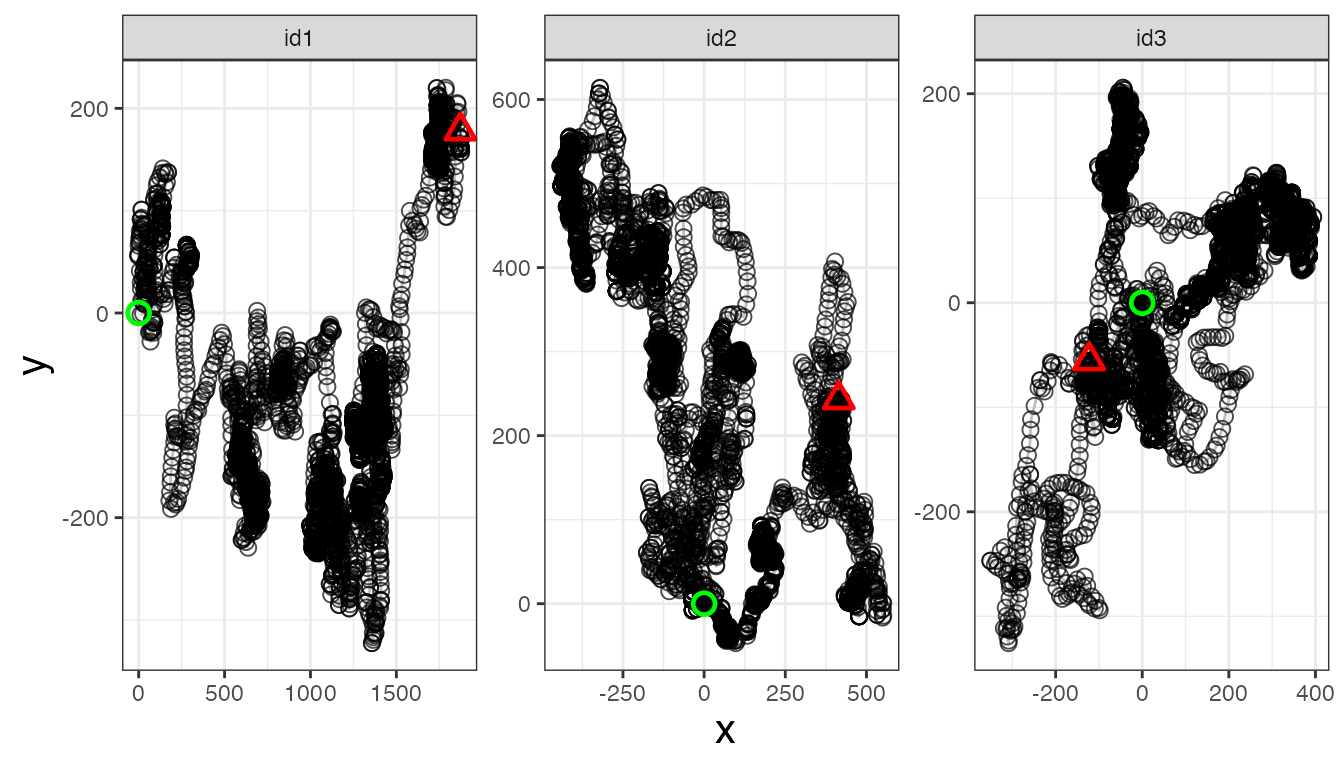
We can see that ‘date’ is in a POSIXct format and that
the x and y coordinates are stored as numeric variables.
Technically, the coordinates can be in a lat-lon format, but this will
make interpretation of step lengths more difficult since they will be
recorded in map units. Therefore, it is suggested that x and y
coordinates are in a UTM projection where the unit of measure is meters.
The ‘id’ column can be stored either as character or
factor.
Now, let’s calculate step length, turning angle, and time interval:
tracks<- prep_data(dat = tracks, coord.names = c("x","y"), id = "id")
head(tracks)
#> id date x y step angle NSD dt
#> 1 id1 2020-07-02 11:59:41 0.00000 0.0000000 10.695 NA 0.000 3526
#> 2 id1 2020-07-02 12:58:26 10.56492 -1.6654990 14.974 0.227 114.392 3664
#> 3 id1 2020-07-02 13:59:31 25.50174 -0.6096675 11.653 0.987 650.710 3716
#> 4 id1 2020-07-02 15:01:27 31.22014 9.5438464 11.449 0.067 1065.782 3509
#> 5 id1 2020-07-02 15:59:56 36.15821 19.8737009 7.237 0.032 1702.380 3522
#> 6 id1 2020-07-02 16:58:38 39.06810 26.4996352 0.119 -2.804 2228.547 3738The new tracks data frame has three new columns (‘step’, ‘angle’, and
‘dt’), which store the data for step lengths, turning angles, and time
intervals, respectively. Since this example uses coordinates that are
considered to be in a UTM projection, step lengths are reported in
meters. Turning angles are reported in radians and time intervals are
reported in seconds. Alternatively, these measures can also be
calculated using functions from other R packages, such as
momentuHMM or adehabitatLT.
Round times and filter observations
Next, we want to filter the data so that we only retain data for a given time interval (or step). Let’s look at a distribution of the time intervals that were just calculated:

Based on this histogram, it appears that 3600 s (1 hour) is likely the primary time interval, where some observations slightly deviate from this exact interval. I will now round all time intervals (dt) and dates to reflect this rounding of times within a given tolerance window. In this example, I will choose 3 minutes (180 s) as the tolerance on which to round observations close to the primary time interval (3600 s).
tracks<- round_track_time(dat = tracks, id = "id", int = 3600, tol = 180, time.zone = "UTC",
units = "secs")
head(tracks)
#> id date x y step angle NSD dt
#> 1 id1 2020-07-02 11:59:41 0.00000 0.0000000 10.695 NA 0.000 3600
#> 2 id1 2020-07-02 12:59:41 10.56492 -1.6654990 14.974 0.227 114.392 3600
#> 3 id1 2020-07-02 13:59:41 25.50174 -0.6096675 11.653 0.987 650.710 3600
#> 4 id1 2020-07-02 14:59:41 31.22014 9.5438464 11.449 0.067 1065.782 3600
#> 5 id1 2020-07-02 15:59:41 36.15821 19.8737009 7.237 0.032 1702.380 3600
#> 6 id1 2020-07-02 16:59:41 39.06810 26.4996352 0.119 -2.804 2228.547 3600
# How many different time intervals?
n_distinct(tracks$dt)
#> [1] 112
# How many observations of each time interval?
hist(tracks$dt, main = "Rounded Time Intervals (s)")
It looks like nearly all observations had a time interval within the
tolerance limit. Now the dataset needs to be filtered to only include
observations where dt == 3600.
# Create list from data frame
tracks.list<- df_to_list(dat = tracks, ind = "id")
# Filter observations
tracks_filt.list<- filter_time(dat.list = tracks.list, int = 3600)
# View sample of results
head(tracks_filt.list[[3]])
#> id date x y step angle NSD dt
#> 1 id3 2020-07-02 12:01:26 0.000000e+00 0.000000e+00 0.000 NA 0.000 3600
#> 2 id3 2020-07-02 13:01:26 -6.164902e-05 -6.576507e-05 0.145 2.728 0.000 3600
#> 3 id3 2020-07-02 14:01:26 1.336034e-01 5.716719e-02 0.001 -2.109 0.021 3600
#> 4 id3 2020-07-02 15:01:26 1.335014e-01 5.640661e-02 3.321 -0.842 0.021 3600
#> 5 id3 2020-07-02 17:04:44 -2.601031e+00 -1.807549e+00 11.272 0.120 10.033 3600
#> 6 id3 2020-07-02 18:04:44 8.594375e+00 -4.939411e-01 0.000 2.125 74.107 3600
#> obs time1
#> 1 1 1
#> 2 2 2
#> 3 3 3
#> 4 4 4
#> 5 6 5
#> 6 7 6
# Check that only observations at 1 hour time intervals are retained per ID
purrr::map(tracks_filt.list, ~n_distinct(.$dt))
#> $id1
#> [1] 1
#>
#> $id2
#> [1] 1
#>
#> $id3
#> [1] 1There are also two new columns that have been added to the data frame of each ID: ‘obs’ and ‘time1’. The ‘obs’ column holds the number of the observation before the data were filtered, whereas ‘time1’ stores the number of the observation after filtering. This is important since the ‘obs’ column will allow the merging of results from this model with that of the original data and the ‘time1’ column will be used to segment the tracks.
Discretize data streams
The unique feature of this modeling framework is that it does not rely upon standard parametric density functions that are used in nearly every other model that estimates behavior. This is expected to reduce any constraints posed by the selection of a given parametric density function and allow for greater model flexibility. However, this does require the user to define the number of bins for each variable and how they will be discretized.
Let’s first take a look at how step lengths and turning angles are distributed:
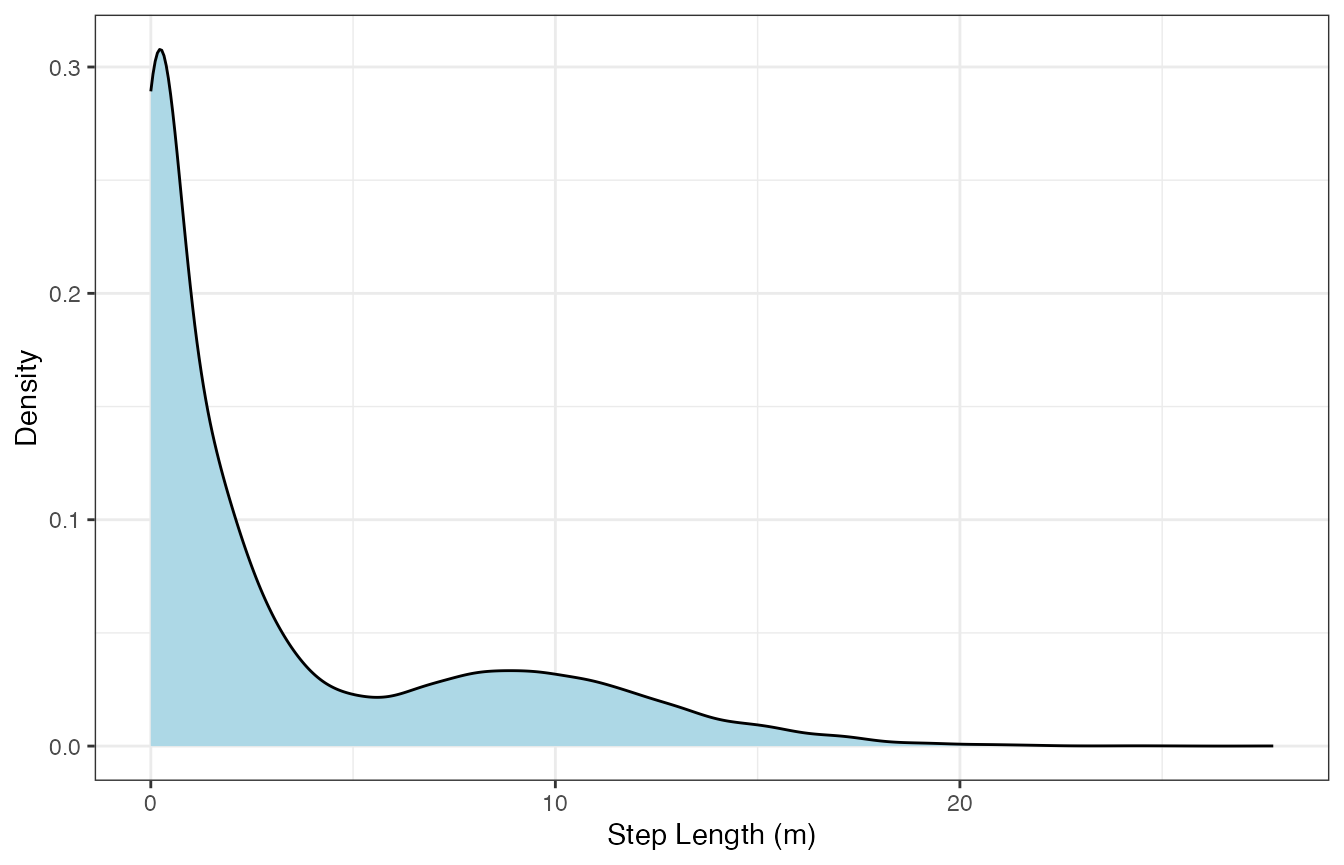
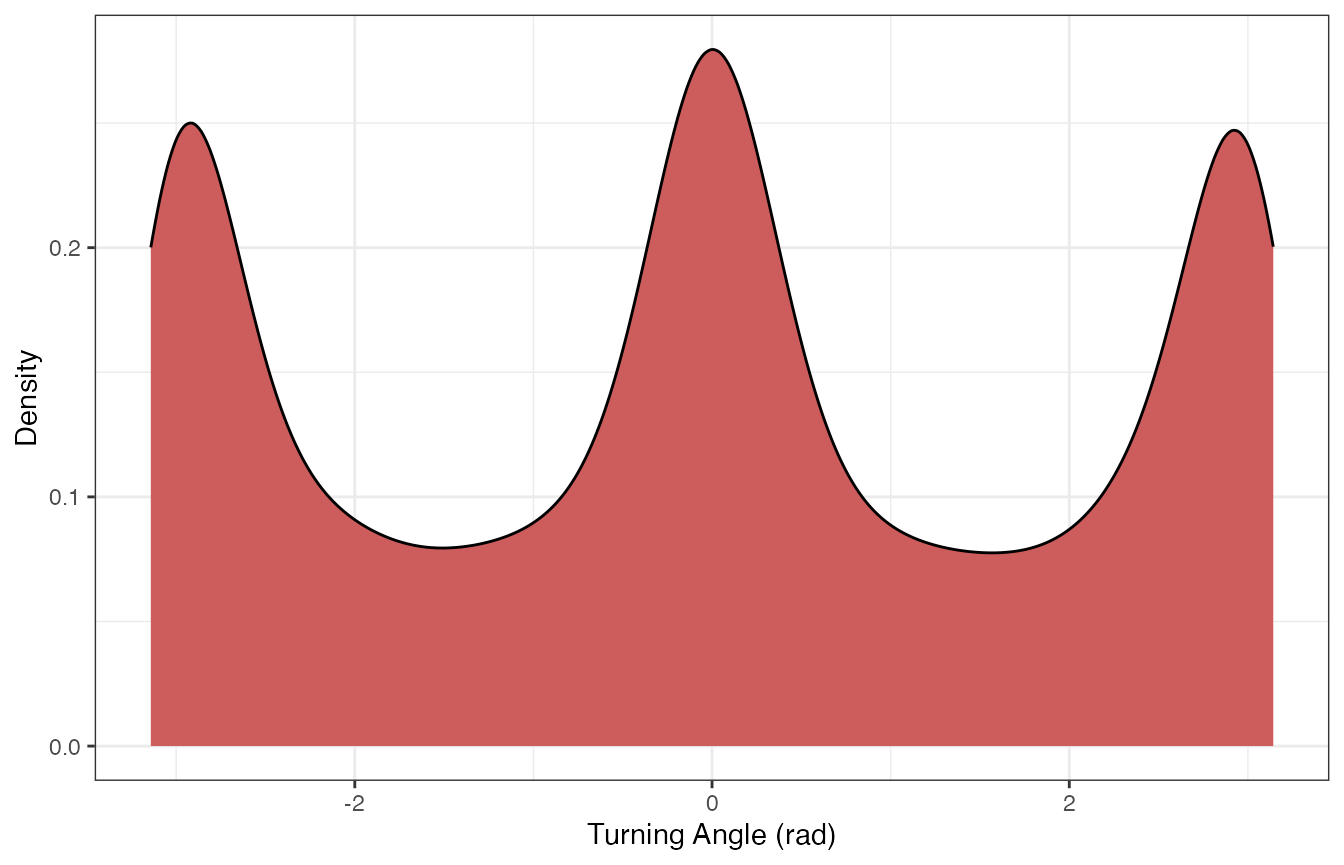
We can see that step lengths are highly right-skewed whereas turning angles are a little more balanced despite having peaks at \(-\pi, 0\), and \(\pi\) radians. These distributions will inform how we discretize these variables.
An example is included below for the discretization of step lengths and turning angles, but this can be performed in many different ways.
# Define bin number and limits for turning angles
angle.bin.lims=seq(from=-pi, to=pi, by=pi/4) #8 bins
# Define bin number and limits for step lengths
dist.bin.lims=quantile(tracks[tracks$dt == 3600,]$step,
c(0,0.25,0.50,0.75,0.90,1), na.rm=T) #5 bins
angle.bin.lims
#> [1] -3.1415927 -2.3561945 -1.5707963 -0.7853982 0.0000000 0.7853982 1.5707963
#> [8] 2.3561945 3.1415927
dist.bin.lims
#> 0% 25% 50% 75% 90% 100%
#> 0.00000 0.10700 1.27900 5.73825 10.75250 25.25200Bins were defined in different ways for each data stream due to their inherent properties. Step lengths were broken into 5 bins (6 limits) using quantiles, which assisted in creating a more balanced distribution of bins since step lengths are typically right-skewed. Only step lengths that were observed at the primary time interval (3600 s; 1 h) were used to calculate quantiles. Since turning angles are already relatively balanced, these were separated into 8 bins (9 limits) of equal width centered at 0 radians (from \(-\pi\) to \(\pi\)). The following code shows how to use these limits to discretize the data:
# Assign bins to observations
tracks_disc.list<- map(tracks_filt.list,
discrete_move_var,
lims = list(dist.bin.lims, angle.bin.lims),
varIn = c("step", "angle"),
varOut = c("SL", "TA"))The plots below show the limits used to define the bins for each continuous variable, as well as what these distributions look like after discretization. First, step lengths will be shown:
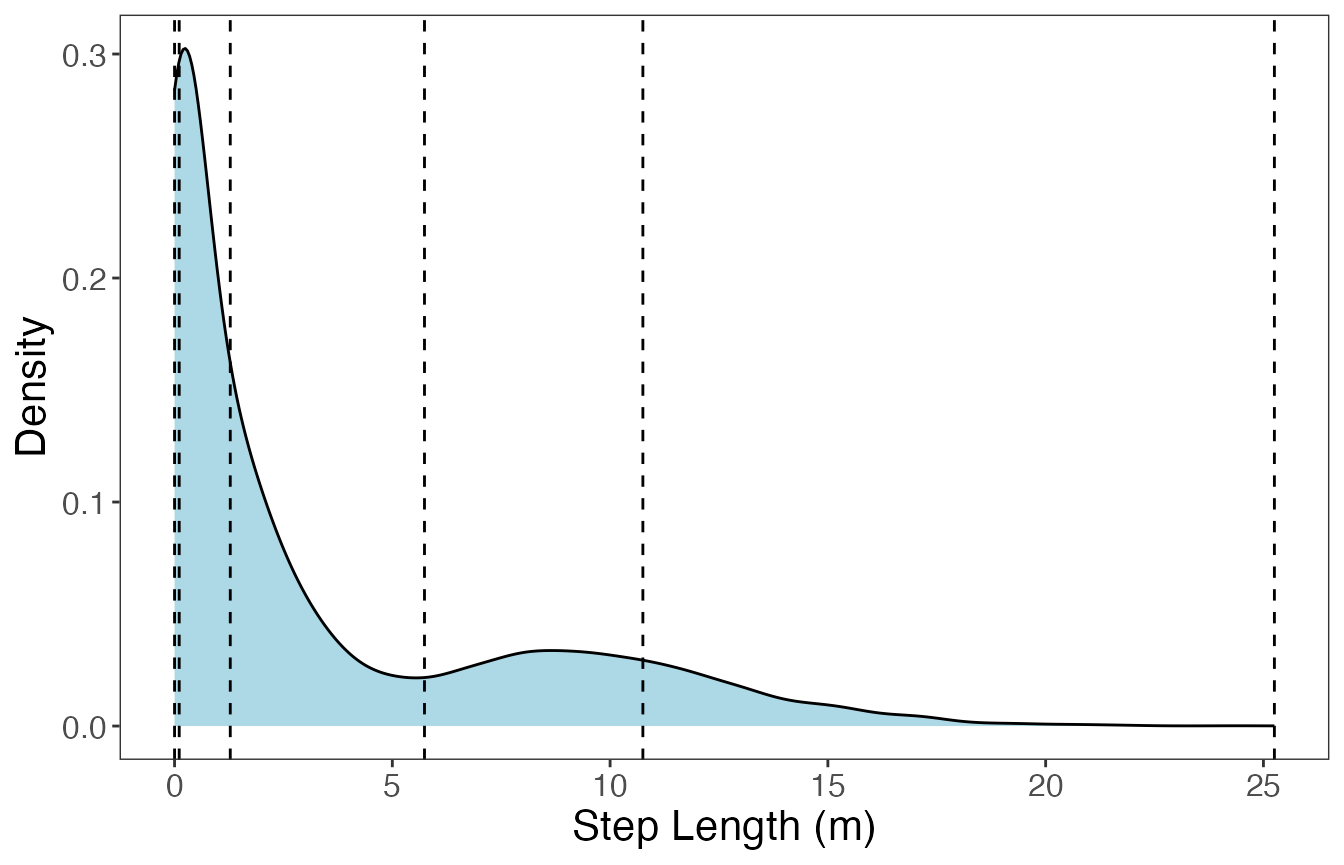
#> `summarise()` has grouped output by 'key'. You can override using the `.groups`
#> argument.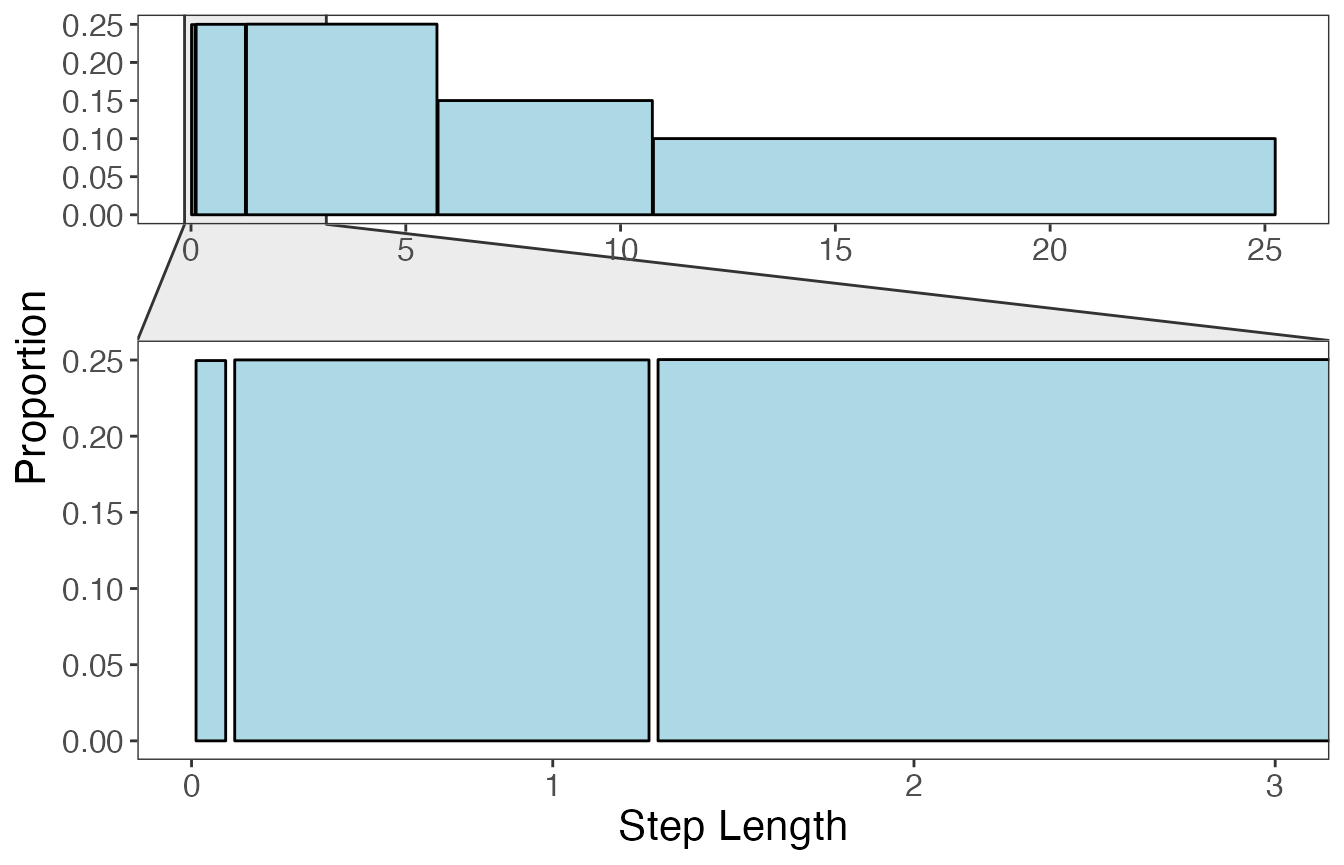
And next the plots for turning angles:
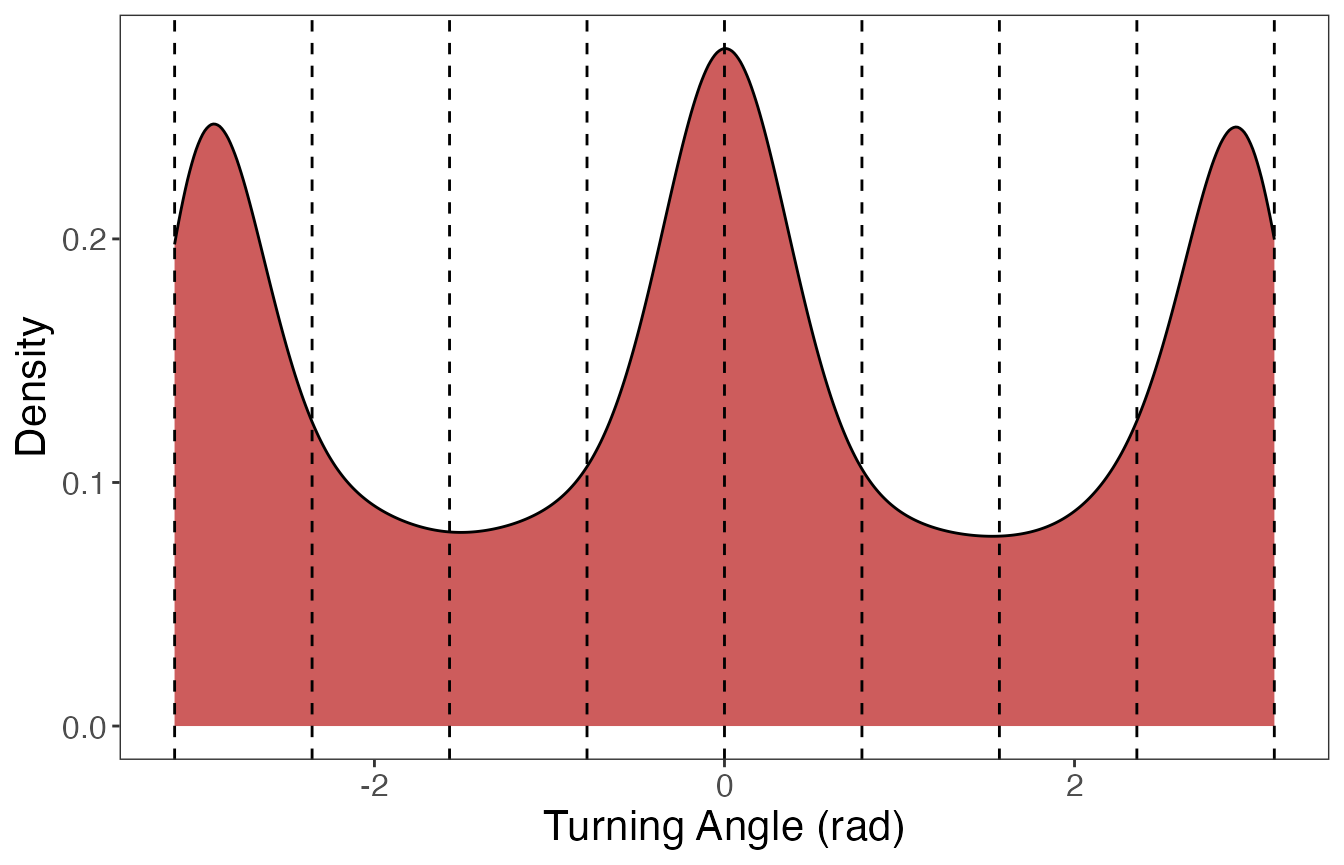
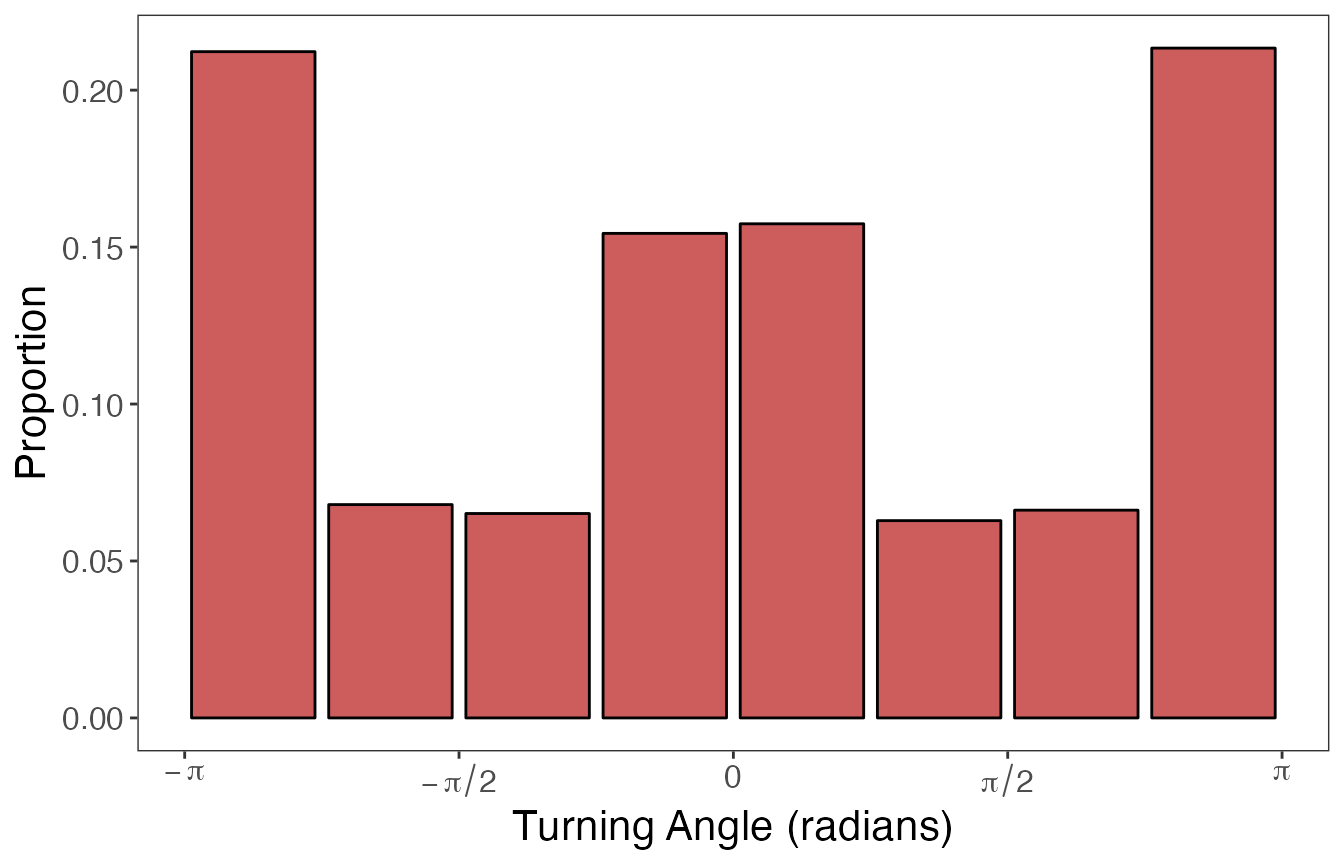
The data are now in the proper format to be analyzed by the
segmentation model within bayesmove. While these bin limits
are suggested as default settings, they are by no means the only way to
discretize the data. This may require trial and error after viewing
results from the segmentation model.